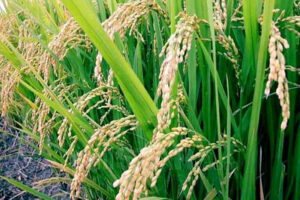
Rice variety resistant to heat, drought to be launched in 2026, IRRI says
A new variety of rice that can withstand hotter climates, survive weeks without water, and cut growing costs may be released by 2026, the International Rice Research Institute (IRRI) said.
“We started in 2022. We already have selections for stage 2, and we are yet to select the one that we will be nominating to the National Cooperative Test (NCT) once we harvest those that we have in stage 2,” according to Mary Jean Du, IRRI regional breeding lead for Southeast Asia, said Monday.
“This year, we have four (breeding) pipelines, from which we will select what we will nominate to NCT. So in two more years, a new variety may come out,” she added.
The four pipelines are: direct seeded, early, long, soft, rainfed (DELS-R), direct seeded, early, long, soft, irrigated (DELS-I), transplanted, early, long, soft, rainfed (TELS-R), and transplanted, early, long, soft, irrigated (TELS-I).
Under the OneRice PH program, IRRI, the University of the Philippines Los Baños, and the Philippine Rice Research Institute will each nominate 100 entries for the NCT.
“So we have a total of 300 entries that we test across our phenotyping sites, and then we cull and select at least 20% that will proceed to stage 2,” she said.
“After which, we will screen them again for another two seasons and select the very promising ones for nomination,” she added.
Maria Cristina Heredia, IRRI Field Phenotyping and Analysis assistant scientist, said that the drought-resistant varieties can survive two to three weeks without water.
“During that span, they are still able to yield, and then we lightly water them, and then we leave it for another two weeks without water,” Ms. Heredia said.
She said that directly seeded non-drought-resistant rice usually only lasts two to three days without water.
“The advantage of being drought-tolerant is that even if the area is always subjected to water stress, it will still survive and yield,” she added.
In terms of savings, Ms. Du said that the direct seeded breeding pipeline will help farmers reduce costs. Conventional farming, which involves transplanting, usually costs farmers P60,000–P70,000 per hectare.
“With transplanting, they will need to hire many people, unlike with direct-seeded, where they can use machines. I think the Philippine Center for Postharvest Development and Mechanization has started distributing the seeders,” she added.
Meanwhile, Ms. Du said that a facility for speed breeding in IRRI is set to be finished within the month, which can reduce the breeding cycle to two to four years.
“The conventional time frame takes 10–12 years. And this is advantageous for the Philippines since both IRRI and the facility are here,” she said.
“The facility may be finished within this month and may open or start operations next month,” she added.
In a statement late Tuesday, IRRI announced the establishment of the University of the Philippines Los Baños (UPLB) Agricultural Genomics Research Center (AGRC) Project Steering Committee.
The committee will guide the construction of a $5-million AGRC, which is part of a $14.97-million six-year project funded by the Korea International Cooperation Agency (KOICA).
The AGRC is meant to provide capacity building opportunities for scientists from UPLB, IRRI, and Korea. The project is KOICA Philippines’ first research and development project on agriculture with the Philippines’ national university. — Justine Irish DP Tabile



